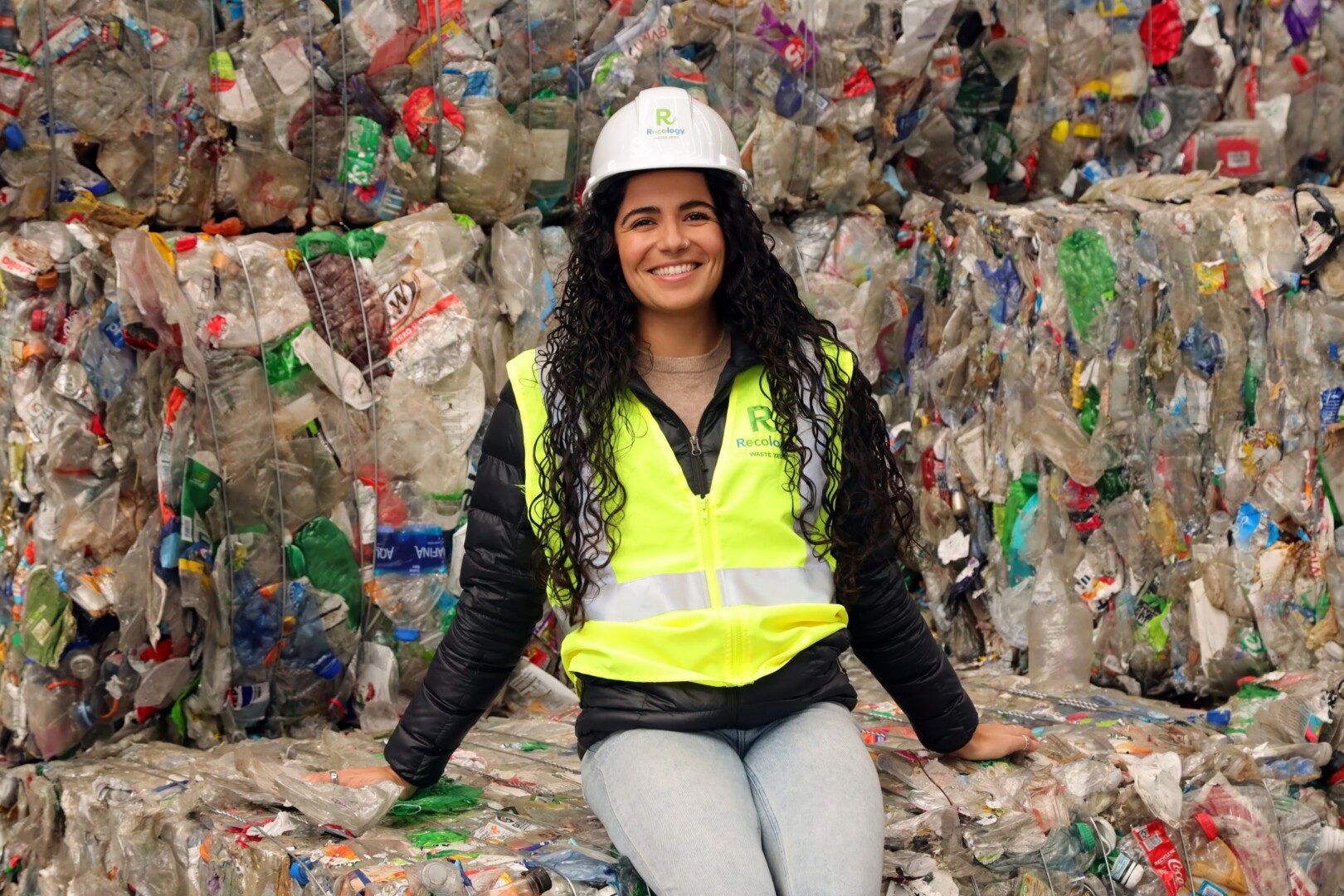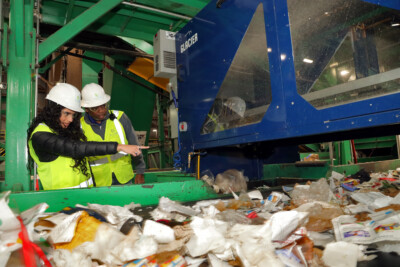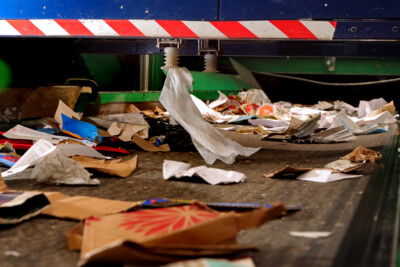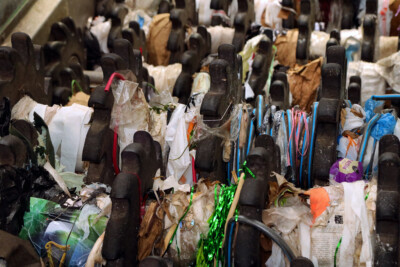
In honor of this year’s Earth Month theme: “Planet vs. Plastics”, Julia Mangin, Head of Sustainability at Recology, recently sat down for a Q&A to dispel some of the myths around recycling, discuss the complexities around the recycling process, and explain the importance of contributing to the circular economy. Read on for Julia’s answers to some of the most frequently asked questions about the recycling process.
Can you explain the Recology vision and how it aligns with this year’s Earth Month theme: “Planet vs. Plastics”?
I love this year’s theme because it matches perfectly with our vision of a world without waste, which to us means first reducing waste, and ultimately eliminating it altogether. The Planet vs. Plastics campaign demands that we reduce the production of plastics in the short term, then eventually create a plastic-free future. Pretty similar, right?
It’s important to recognize that aspirational goals like eliminating plastics won’t happen overnight, but they can act as a North Star of sorts that we can use to guide our actions in the near term. Before we can collectively eradicate plastics, we at Recology feel like we can really contribute to keeping existing material in circulation to be repurposed and reused rather than sending it to a landfill and then extracting valuable resources just to make new plastics. To me, supporting the circular economy is a no-brainer, and definitely feels like picking team planet over team plastic.
There are reports out there that say the majority of recyclable plastics end up in landfills instead of successfully being recycled. Is that true?
We get asked about those reports a lot. No, it’s not completely true, and I think it’s important to not get caught by flashy headlines and instead take the time to understand what reports like these are actually saying. Otherwise, they can be misleading. Most of these reports are referring to all plastics that get produced, and not just those that are being placed in recycling bins.
The unfortunate reality is that many recyclable plastics don’t even make it into the recycling bin at all. The Recycling Partnership just recently released their State of Recycling Report which found that 76% of all residential recyclables are lost at the household level, and this percentage was even higher for plastics. So, when ¾ of all recyclable materials, including plastics, that make it into households are just being thrown away, we’re missing the bigger picture by saying that the recycling process is failing.
Recycling isn’t perfect by any means, but if we’re going to question the efficacy of recycling, we also need to address the national issue around access to recycling. That same report found that in contrast to the 76% of all recyclables lost at the household level, only 3% of residential recyclables are lost at Materials Recovery Facilities (MRFs), which shows that the recyclable materials being placed in the recycling bin do in fact get recycled at a very high rate.

Which types of plastics get recycled the most, and which get recycled the least?
Good question, because there are more types of plastics than a lot of people think. The more rigid plastics used to make things like water bottles, milk jugs, detergent bottles, etc. – called #1 (PET) and #2 (HDPE) plastics – get recycled at quite a high rate. The types that are the most successfully recycled at our facilities are hard plastics like yogurt cups, which are called #5 (PP) plastics. At our MRF in San Francisco, we recovered 62% of PET, 67% of HDPE, and 99% of PP in 2022.
The remaining plastic types (#3, #4, #6, and #7) are things like plastic film and bags, single-use plastic utensils, and other miscellaneous plastic products that are generally not recycled in curbside programs, so these are what you want to avoid placing in your recycling bin. Flimsy plastics like film plastics and bags make plastic one of the toughest materials to recycle, which is a great reason why avoiding them altogether and finding reusable alternatives is the best move when possible!
It’s important to add that what gets recycled can vary based on where people live and what facilities and policies are in place. The list I just mentioned pertains to typical recycling success in most of Recology’s service areas, but it’s important to check with your local collection company or city about specific recycling guidelines.
How does Recology ensure that recyclable plastics that make it into recycling bins actually get recycled?
Over the last five years alone, we’ve invested tens of millions of dollars in advanced technologies to upgrade sorting capabilities at our MRFs through things like artificial intelligence, cutting-edge robotics, optical sorters, and much more. By implementing these technologies alongside skilled employees who sort additional plastics by hand, we’ve made a pretty intricate system to be sure as much material gets recycled as possible. It’s incredible to see the technological innovations that are on the market today and are being continuously improved.
We actually just updated our MRF in Santa Rosa, CA earlier this year so it can process around 400 tons of material every day! If you’ve never seen a MRF and live in the area, I highly recommend scheduling a tour to experience firsthand how recyclables are sorted. It’s so impressive and will completely change the way you think about what you put in your bin!

Earlier, you mentioned the “circular economy.” What is the circular economy in your own words, and how does reducing and recycling plastics fit into it?
The circular economy is like a more developed version of the “reduce, reuse, recycle” principle where products and materials are kept in circulation instead of just thrown away shortly after they’re used. In contrast to a linear economy where we take materials from the earth, make products, and then send them to the landfill, we’re better off reusing, repairing, redesigning, recycling, and composting material to keep it in circulation as long as possible.
In a truly circular economy, items like plastic water bottles can be recycled and eventually made into another plastic water bottle or plastic product, saving a bunch of energy and resources in the process.
Are there common mistakes people make when recycling plastics that can significantly impact the recycling process?
Yes, plenty, but it’s not their fault much of the time because information on plastic recycling isn’t always clear! For example, a lot of plastic products have the chasing arrows symbol on them—the three-arrow recycling symbol that forms a triangle—but that doesn’t always mean those products can be recycled curbside. Like I said earlier, recyclability usually depends on the kind of recycling facilities in the region where a person lives, what specific type of plastic the product is made from, and more. It would be much easier if only things that can be recycled curbside have the recycling symbol, but unfortunately, it’s not that simple.
A lot of people are also “wishcycling,” which is when they place something in their recycling bin with the hopes that it’ll get recycled, even if they’re not sure if it’s actually recyclable. Although that may seem helpful, it creates contamination that puts a lot of strain on the system. We encourage everyone to educate themselves about what materials can be recycled where they live. A good general rule of thumb is to throw away flimsy plastics and recycle hard plastics as long as they’re empty, clean, and dry, but it’s still important to check with your local collection company.

How can people get involved beyond recycling correctly?
I’d encourage people to replace disposable items with reusable items whenever possible. When you’re about to purchase or consume something that will go straight to a landfill when you’re done with it, ask yourself if there is a substitute you can keep and reuse instead. If you have to use single-use plastics, try to stick to plastics that can be recycled where you live and make sure they actually make it into your bin. If you do this most of the time – because I get it, no one is perfect – you’ll be contributing to the greater process to keep things from going to waste.
I also think it’s important to acknowledge the role that companies play in the circular economy, because the responsibility to recycle can’t and shouldn’t just fall on individuals. It’s irresponsible for big brands and manufacturers to continue pumping single-use packaging and products into our economy without any accountability for what happens to them. Along with companies like Recology, these companies need to play a short-term role to help keep materials in circulation when possible. This can involve, for example, reducing their packaging, redesigning their products and packaging with recyclable materials, or investing in infrastructure to improve collection and sorting, and more.
At Recology, we’re really proud of the infrastructure and systems we’ve built to maximize what gets recycled. But we’re only one part of a massive system. I may be a bit of an idealist, but I truly believe that if each of us embraces our role, we can build circular systems that actually work!
Julia Mangin is the head of sustainability at Recology, where she leads the company’s sustainability initiatives and partnerships. With nearly 10 years of experience working in the resource recovery industry, Julia is an expert in the circular economy and is also one of this year’s recipients of Waste360’s 40 Under 40 award. Julia holds a Bachelor of Science degree in Environmental Sciences from the University of California, Berkeley.